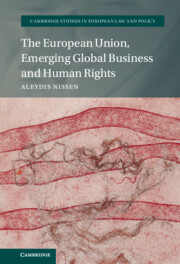Book contents
- The European Union, Emerging Global Business and Human Rights
- Cambridge Studies in European Law and Policy
- The European Union, Emerging Global Business and Human Rights
- Copyright page
- Dedication
- Epigraph
- Contents
- Foreword
- Series Preface
- Acknowledgements
- Tables of Treaties and Cases
- Abbreviations
- 1 Introduction
- Part I International Perspective
- Part II Perspective of the European Union and Its Member States
- Part III Perspective of Developing and Emerging States
- Select Bibliography
- Index
1 - Introduction
Published online by Cambridge University Press: 10 November 2022
- The European Union, Emerging Global Business and Human Rights
- Cambridge Studies in European Law and Policy
- The European Union, Emerging Global Business and Human Rights
- Copyright page
- Dedication
- Epigraph
- Contents
- Foreword
- Series Preface
- Acknowledgements
- Tables of Treaties and Cases
- Abbreviations
- 1 Introduction
- Part I International Perspective
- Part II Perspective of the European Union and Its Member States
- Part III Perspective of Developing and Emerging States
- Select Bibliography
- Index
Summary
The main contribution of this book lies in narrowing the existing research gap on the accountability of transnational corporations from emerging and developing states. In addition, it provides a new perspective on the widely documented poor track record of EU Member States in terms of holding ‘their’ corporate nationals, which are directly competing with these corporations for the same ‘share of wallet’ in the globalised marketplace, accountable. Any legal study of a level playing field requires the study of mandatory requirements as a matter of regulatory compliance. This book thus needs to study ‘hard law obligations’ in business and human rights. It assesses how regulation (in laws and trade agreements) and civil judicial remediation in the EU and its Member States function in relation to corporations from emerging and developing states in our globalised world. This book relies on two models of international law-making: constructivism and rationalism.
Keywords
- Type
- Chapter
- Information
- Publisher: Cambridge University PressPrint publication year: 2022



